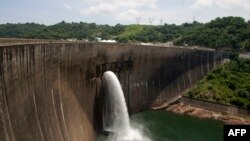Experts report that Zambia and Zimbabwe have been experiencing 12-hour power cuts that started in December after water levels at the Kariba hydropower dam plunged to an all-time low.
Experts added that both nations are dependent on Lake Kariba for majority of their hydroelectric needs and that President Hakainde Hichilema’s administration has addressed power cuts in their nation, however President Emmerson Mnangagwa’s nation is behind.
Peter Chibwe Kapala, Zambia’s Minister of Energy said his nation plans to invest $2 billion into their energy sector which will result in surplus power that will be exported to neighboring nations.
“Solar will play a bigger role so that in times of drought, we could use less water to generate (electricity),” said Kapala.
“During the daytime, I want to generate more from solar and export more on hydro because it doesn’t fluctuate that much,” he added.
Tendayi Marowa, a consultant with Independent Renewable Energy supported the position taken by Kapala’s ministry.
“The use of solar energy, be it solar PV for electricity or solar thermal for water heating, can actually reduce the demand for electricity considerably. So the residential area must be encouraged to install solar panels on their roofs,” said Marowa.
Marowa also urged Zambian and Zimbabwean authorities to build more hydropower stations upstream of Kariba Dam, along the Zambezi River which separates the two nations.
Munyaradzi Munodawafa, the chief executive of the Zambezi River Authority which manages Kariba Dam, said Marowa’s proposal would generate approximately 14,000 megawatts of electricity per year on the river.
“So, of that 14,000 (megawatts), we have only managed to come up with 2,130 megawatts- that is at Kariba,” said Munodawafa.
“So we are left with another 12,000 (megawatts), which we can put across so that whether there is climate change or no climate change, the two countries won’t be affected in terms of the load,” he added.






